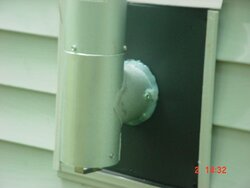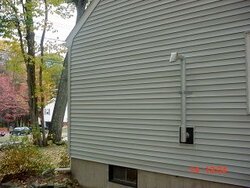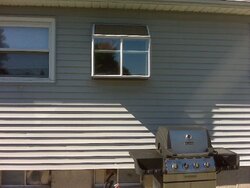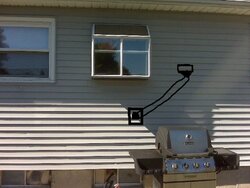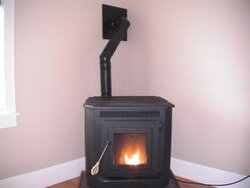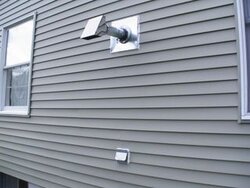Well I am going to attempt to install my pellet stove myself. Its going to be a straight out horizontal install. Going through some horse hair plaster and the outside of the house is vinyl sided. I tried doing a search for some install pics and only found a couple. So I was wondering if a few could post some pics of their install chimney's. I guess what I am looking for is how it looks with the vinyl siding and how much I need to cut. Would I just cut the hole in the vinyl siding for the thimble and then screw the thimble over the siding? Or cut a square the size of the thimble and then buy some edging of the siding and square it off? Thanks in advance for the advice...
Looking for some install pics please!!
- Thread starter teamorange
- Start date
-
Active since 1995, Hearth.com is THE place on the internet for free information and advice about wood stoves, pellet stoves and other energy saving equipment.
We strive to provide opinions, articles, discussions and history related to Hearth Products and in a more general sense, energy issues.
We promote the EFFICIENT, RESPONSIBLE, CLEAN and SAFE use of all fuels, whether renewable or fossil.
You are using an out of date browser. It may not display this or other websites correctly.
You should upgrade or use an alternative browser.
You should upgrade or use an alternative browser.
- Status
- Not open for further replies.
firewarrior820
Feeling the Heat
orangecrushcj7
Feeling the Heat
yes, cut the siding the same size as the square of the thimble, then buy and install "j-channel" as the picture above shows.
Xpellet, are you going up the house with the rest of the chimney or is it capped right above the T? Just curious...
firewarrior820
Feeling the Heat
Maineiac
Member
xpellet freakx said:total of 60 inches
Does this configuration keep the soot off your siding? My install goes straight out on the north side of my house and I get a ton of soot stain even though it continues about two feet beyond the siding. I also don't want to run straight up on the outside past my roofline since there is a window on the second floor and this is the gable end of my cape. This looks pretty good to me.
firewarrior820
Feeling the Heat
I haven't noticed any, i've burned about 7 bags so far.
There is a window to the right 48" plus, away. And a window above 5 feet away.
The auburn fire dept has signed off on this install and my ins. co. is happy with it.
There is a window to the right 48" plus, away. And a window above 5 feet away.
The auburn fire dept has signed off on this install and my ins. co. is happy with it.
Wow, that does look good. I wish I could do that but since their is a window about 2-3 feet above where I am coming out.
Maineiac does your pipe just come straight out? About a foot away from the house with the cap?
And does anyone know if I can come out and up a foot and put the cap on. I guess my question would be, is the clearance I need still only 3"? So as long as the final pipe up was 3" from the window I should be ok? I attached my pic. Its the window in the middle. I am coming out about 4.5 feet from the ground...
Maineiac does your pipe just come straight out? About a foot away from the house with the cap?
And does anyone know if I can come out and up a foot and put the cap on. I guess my question would be, is the clearance I need still only 3"? So as long as the final pipe up was 3" from the window I should be ok? I attached my pic. Its the window in the middle. I am coming out about 4.5 feet from the ground...
Attachments
MainePellethead
Minister of Fire
Maineiac said:xpellet freakx said:total of 60 inches
Does this configuration keep the soot off your siding? My install goes straight out on the north side of my house and I get a ton of soot stain even though it continues about two feet beyond the siding. I also don't want to run straight up on the outside past my roofline since there is a window on the second floor and this is the gable end of my cape. This looks pretty good to me.
My install is like maniacs but mine goes 8 'up and out. I havent had any staining and have burned half of last season and a little this year. Its all in if the area gets wind and I am fortunate....mine is tucked in a bit out of the wind so I guess that helps. I have light gray siding too so I guess I would see it well lol...but havent had any at all so far

Ok, I might have to make an adjustment now. I was just reading the install manual from the simpson/duravent chimney kit I purchased. Here is what is stated:
C. Follow the below listed NFPA 211 rule for distance of exit terminal from
windows and openings:
NFPA 211 (2003 ed.) Section 10.4 Termination: 10.4.5 (1) The exit terminal
of a mechanical draft system other than a direct vent appliance (sealed combustion
system appliance) shall be located in accordance with the following:
(a) Not less than 3 ft (.91m) above any forced air inlet located within 10 ft. (3m).
(b) Not less than 4 ft. (1.2m) below, 4 ft. (1.2m) horizontally from or 1 ft.
(305mm) above any door, window or gravity air inlet into any building
(c) Not less than 2 ft. (0.61m) from an adjacent building and not less
So if I am reading this correctly, does this mean, I can't vent below a window unless its 4 feet below it? So then could I come out and angle to the right, I put my picture in paint and drew on it. Someone also mentioned that they think I could do it as long as I seal that window so it doesn't open, which would be ok because it only cranks open from the top anyways like 2" or so...
Ideas?
C. Follow the below listed NFPA 211 rule for distance of exit terminal from
windows and openings:
NFPA 211 (2003 ed.) Section 10.4 Termination: 10.4.5 (1) The exit terminal
of a mechanical draft system other than a direct vent appliance (sealed combustion
system appliance) shall be located in accordance with the following:
(a) Not less than 3 ft (.91m) above any forced air inlet located within 10 ft. (3m).
(b) Not less than 4 ft. (1.2m) below, 4 ft. (1.2m) horizontally from or 1 ft.
(305mm) above any door, window or gravity air inlet into any building
(c) Not less than 2 ft. (0.61m) from an adjacent building and not less
So if I am reading this correctly, does this mean, I can't vent below a window unless its 4 feet below it? So then could I come out and angle to the right, I put my picture in paint and drew on it. Someone also mentioned that they think I could do it as long as I seal that window so it doesn't open, which would be ok because it only cranks open from the top anyways like 2" or so...
Ideas?
Attachments
woodsman23
Minister of Fire
teamorange said:Ok, I might have to make an adjustment now. I was just reading the install manual from the simpson/duravent chimney kit I purchased. Here is what is stated:
C. Follow the below listed NFPA 211 rule for distance of exit terminal from
windows and openings:
NFPA 211 (2003 ed.) Section 10.4 Termination: 10.4.5 (1) The exit terminal
of a mechanical draft system other than a direct vent appliance (sealed combustion
system appliance) shall be located in accordance with the following:
(a) Not less than 3 ft (.91m) above any forced air inlet located within 10 ft. (3m).
(b) Not less than 4 ft. (1.2m) below, 4 ft. (1.2m) horizontally from or 1 ft.
(305mm) above any door, window or gravity air inlet into any building
(c) Not less than 2 ft. (0.61m) from an adjacent building and not less
So if I am reading this correctly, does this mean, I can't vent below a window unless its 4 feet below it? So then could I come out and angle to the right, I put my picture in paint and drew on it. Someone also mentioned that they think I could do it as long as I seal that window so it doesn't open, which would be ok because it only cranks open from the top anyways like 2" or so...
Ideas?
In your situation i would try and vent horizontal and be 18" out from the house with a 45 at the end.
woodsman23
Minister of Fire
teamorange said:Ok, so if I come straight out 18" from the house with a cap I should be fine?
That is the way mine is vented and i have no issues, ie: soot on house=no, venting problems=no, Problems when power goes out=no. You still need to be 4' from the above window for code i believe. Looks to me like you little choice except vent straight out and a 45 at the end or you can buy a hansome chrome end cap for big bucks that does the same thing.
OK, I think I am confused now. I come straight out and then a 45 at the end and then what? Up or down? Which way would the 45 point and any other addtional piping? Sorry if I am missing something, been a long day...
sydney1963
New Member
sydney1963
New Member
If you can keep it all under or close to 15 it should work.
A rule of thumb has been adopted by most pellet manufactures. The equation is called the sum of Equivalent Vertical Length (EVL). All of the above mentioned venting restrictions have been assigned EVL values as follows:
Each 45 degree elbow = 3 EVL
Each 90 degree elbow and Tees with cleanout = 5 EVL
Each foot of horizontal run = 1 EVL
Each foot of Vertical run = 0.5 EVL
Elevations above 3000 ft with an EVL of 7 must adapt to 4 inch vent pipe.
If your installation is below 3000ft, do some math. The rule of thumb equations is that if the sum of the EVL is 15 or greater, then the pellet vent pipe would be increased to 4 inch diameter pellet vent pipe.
Check out this link, it has great ideas and explainations.
http://www.nevelsstoves.com/articles/Venting-your-pellet-stove.htm
A rule of thumb has been adopted by most pellet manufactures. The equation is called the sum of Equivalent Vertical Length (EVL). All of the above mentioned venting restrictions have been assigned EVL values as follows:
Each 45 degree elbow = 3 EVL
Each 90 degree elbow and Tees with cleanout = 5 EVL
Each foot of horizontal run = 1 EVL
Each foot of Vertical run = 0.5 EVL
Elevations above 3000 ft with an EVL of 7 must adapt to 4 inch vent pipe.
If your installation is below 3000ft, do some math. The rule of thumb equations is that if the sum of the EVL is 15 or greater, then the pellet vent pipe would be increased to 4 inch diameter pellet vent pipe.
Check out this link, it has great ideas and explainations.
http://www.nevelsstoves.com/articles/Venting-your-pellet-stove.htm
woodsman23
Minister of Fire
Ok, so my kit includes the fancy end cap, so with the 12-18" from the house, straight out, add the fancy end cap pointing down and this should be ok even if this is only 26" below the window?
rap69ri
Minister of Fire
sydney1963
New Member
If this your only option I would seal it shut as it doesn't provide much fresh air or an escape route.
Yeah it is a crank window that only opens the very top of the window, only about 2" when fully cranked. So if I seal that shut, I should be ok?
sydney1963
New Member
You want to seal it so no smoke can get inside your home. Very toxic. Also, I would move your gas grill as the vented air will be quite warm. And if you are going straight out make sure you provide the stove with outside air so during a power outage it will get some kind of natural draft so you don't get smoke back in your house. If you have an Elglander I think the instructions tell you that you can only go up and out or out and up and the outside airkit is a must do. I purchased the Dura Vent kit and then had to buy a 45 degree elbow ($35) to make it work for a corner. The elbows do turn slightly so you can make it work. It can be a puzzle. Have fun.
Go here too if you have other questions.
If you can keep it all under or close to 15 it should work.
A rule of thumb has been adopted by most pellet manufactures. The equation is called the sum of Equivalent Vertical Length (EVL). All of the above mentioned venting restrictions have been assigned EVL values as follows:
Each 45 degree elbow = 3 EVL
Each 90 degree elbow and Tees with cleanout = 5 EVL
Each foot of horizontal run = 1 EVL
Each foot of Vertical run = 0.5 EVL
Elevations above 3000 ft with an EVL of 7 must adapt to 4 inch vent pipe.
If your installation is below 3000ft, do some math. The rule of thumb equations is that if the sum of the EVL is 15 or greater, then the pellet vent pipe would be increased to 4 inch diameter pellet vent pipe.
Mine actually worked out to be 17 and all is well.
Check out this link, it has great ideas and explainations.
http://www.nevelsstoves.com/articles/Venting-your-pellet-stove.htm
Go here too if you have other questions.
If you can keep it all under or close to 15 it should work.
A rule of thumb has been adopted by most pellet manufactures. The equation is called the sum of Equivalent Vertical Length (EVL). All of the above mentioned venting restrictions have been assigned EVL values as follows:
Each 45 degree elbow = 3 EVL
Each 90 degree elbow and Tees with cleanout = 5 EVL
Each foot of horizontal run = 1 EVL
Each foot of Vertical run = 0.5 EVL
Elevations above 3000 ft with an EVL of 7 must adapt to 4 inch vent pipe.
If your installation is below 3000ft, do some math. The rule of thumb equations is that if the sum of the EVL is 15 or greater, then the pellet vent pipe would be increased to 4 inch diameter pellet vent pipe.
Mine actually worked out to be 17 and all is well.
Check out this link, it has great ideas and explainations.
http://www.nevelsstoves.com/articles/Venting-your-pellet-stove.htm
DiggerJim
Feeling the Heat
Your link's statement to the contrary, I believe EVL stands for "EQUIVALENT VENT LENGTH".sydney1963 said:A rule of thumb has been adopted by most pellet manufactures. The equation is called the sum of Equivalent Vertical Length (EVL).
Each foot of horizontal run = 1 EVL
Each foot of Vertical run = 0.5 EVL
Otherwise calculating an equivalent vertical length for a vertical section (.5 EVL in your post) would be nonsensical - i.e. a foot of vertical pipe is equal to .5 feet of equivalent vertical length...and a foot of horizontal pipe length is equal to 1 foot of equivalent vertical length.
It makes you wonder what else Nevels Stoves got wrong. Perhaps they might want to read page 7 of the Breckwell manuals they have a link to on their website.
I love "professionals". I'm still chuckling.

sydney1963
New Member
- Status
- Not open for further replies.
Similar threads
- Replies
- 5
- Views
- 806
- Replies
- 15
- Views
- 1K
- Replies
- 3
- Views
- 646
- Replies
- 7
- Views
- 782


